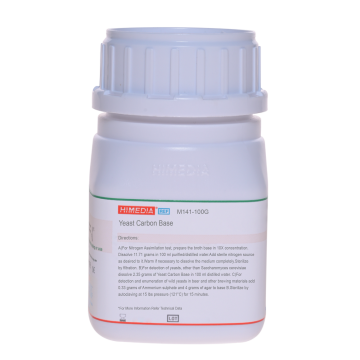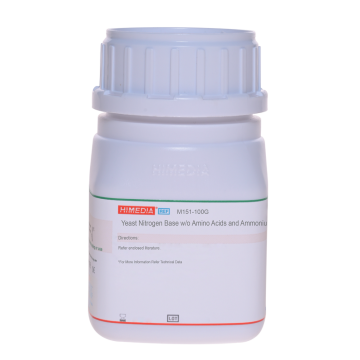 Your enquiry has been submitted
Your enquiry has been submitted
Yeast Morphology Agar
Intended Use:
Recommended for classification of yeasts on the basis of their colonial characteristics and cell morphology.
Composition**
| Ingredients | Gms / Litre |
|---|---|
| Ammonium sulphate | 3.500 |
| Asparagine | 1.500 |
| Dextrose (Glucose) | 10.000 |
| L-Histidine monohydrochloride | 0.010 |
| DL-Methionine | 0.020 |
| DL-Tryptophan | 0.020 |
| Biotin | 0.000002 |
| Calcium pantothenate | 0.0004 |
| Folic acid | 0.000002 |
| Inositol | 0.002 |
| Niacin | 0.0004 |
| p-Amino benzoic acid (PABA) | 0.0002 |
| Pyridoxine hydrochloride | 0.0004 |
| Riboflavin (Vitamin B2) | 0.0002 |
| Thiamine hydrochloride | 0.0004 |
| Boric acid | 0.0005 |
| Copper sulphate | 0.00004 |
| Potassium iodide | 0.0001 |
| Ferric chloride | 0.0002 |
| Manganese sulphate | 0.0004 |
| Sodium molybdate | 0.0002 |
| Zinc sulphate | 0.0004 |
| Potassium dihydrogen phosphate | 1.000 |
| Magnesium sulphate | 0.500 |
| Sodium chloride | 0.100 |
| Calcium chloride anhydrous | 0.100 |
| Agar | 18.000 |
Final pH (at 25°C): 5.6±0.2
**Formula adjusted, standardized to suit performance parameters
Directions
Suspend 34.75 grams in 1000 ml purified / distilled water. Heat to boiling to dissolve the medium completely. Sterilize by autoclaving at 15 lbs pressure (121°C) for 15 minutes. Cool to 45-50°C. Pour into sterile Petri plates to a depth of 1.5 mm. Allow the media surface to dry for one or two days at room temperature. Use light inoculum and make a single streak and two point inoculations near the other sides of the plate.
Principle And Interpretation
Yeasts are ubiquitous in our environment, being found on fruits, vegetables and plant materials. Yeasts are unicellular, eukaryotic, budding cells that are generally round to oval or, less often, elongated or irregular in shape. Colonies of yeasts have a smooth to wrinkled, creamy appearance (3). Yeast Morphology Agar is formulated as described by Wickerham (4-7). The medium is a highly enriched medium, which provides all the growth factors required by yeasts. Yeast Morphology Agar is employed to study the cellular morphology, formation of mycelia and pseudomycelia and other cultural characteristics. Various media constituents provide carbon, nitrogen, amino acids, vitamins and trace salts required by yeasts. The medium plates are inoculated by the Dolmans technique (3). Using a light inoculum from an actively growing culture, smear a single line at one end of the plate and in two separate points at the opposite end. Place two sterile slides, one on the central section of the smear and one on one of the two-punctiform inocula. After an incubation of 72-96 hours, take off the growth of the point inoculations and the smear without the slide and observe the morphology of the vegetative cells under a microscope. Also observe the zone underlying the slides for the formation of mycelium or pseudomycelium under the microscope. Observe the colonial morphology.
Type of specimen
Pure isolates
Specimen Collection and Handling:
For pure isolates samples follow appropriate techniques for handling specimens as per established guidelines (1,2). After use, contaminated materials must be sterilized by autoclaving before discarding.
Warning and Precautions :
Read the label before opening the container. Wear protective gloves/protective clothing/eye protection/ face protection. Follow good microbiological lab practices while handling specimens and culture. Standard precautions as per established guidelines should be followed while handling specimens. Safety guidelines may be referred in individual safety data sheets.
Limitations :
- Use light inoculum and make a single streak and two point inoculations near the other sides of the plate.
Performance and Evaluation
Performance of the medium is expected when used as per the direction on the label within the expiry period when stored at recommended temperature.
Quality Control
Appearance Cream to yellow homogeneous free flowing powder
Gelling Firm, comparable with 1.8% Agar gel.
Colour and Clarity of prepared medium Light amber coloured slightly opalescent gel forms in Petri plates.
Reaction Reaction of 3.47% w/v aqueous solution at 25°C. pH : 5.6±0.2
pH 5.40-5.80
Cultural Response
Cultural characteristics observed after an incubation at 25-30°C for 6-7 days.
| Organism | Growth | Morphology |
|---|---|---|
| Candida albicans ATCC 10231 (00054*) | good | hyphae |
| Kloeckera apiculata ATCC 9774 | good | - |
| Saccharomyces uvarum ATCC 9080 | good | - |
Key: *Corresponding WDCM numbers.
Storage and Shelf Life
Store dehydrated and the prepared medium at 2-8°C. Use before expiry date on the label. On opening, product should be properly stored dry, after tightly capping the bottle in order to prevent lump formation due to the hygroscopic nature of the product. Improper storage of the product may lead to lump formation.
Store in dry ventilated area protected from extremes of temperature and sources of ignition. Seal the container tightly after use. Use before expiry date on the label.
Product performance is best if used within stated expiry period.
Disposal
User must ensure safe disposal by autoclaving and/or incineration of used or unusable preparations of this product. Follow established laboratory procedures in disposing of infectious materials and material that comes into contact with sample must be decontaminated and disposed of in accordance with current laboratory techniques (1,2).
Reference
- Isenberg, H.D. Clinical Microbiology Procedures Handbook 2nd Edition.
- Jorgensen, J.H., Pfaller, M.A., Carroll, K.C., Funke, G., Landry, M.L., Richter, S.S and Warnock., D.W. (2015) Manual Clinical Microbiology, 11th Edition. Vol. 1.
- Murray P. R., Baron J. H., Pfaller M. A., Jorgensen J. H. and Yolken R. H., (Ed.), Manual of Clinical Microbiology, 8th Ed., 2003, American Society for Microbiology, Washington, D.C.
- Wickerham L. J., 1951, U.S. Dept. Agric. Tech. Bull. No. 1029.
- Wickerham L. J., 1939, J. Tropical Med. Hyg. 42:176.
- Wickerham L. J., 1948, J. Bacteriol., 56:363.
- Wickerham L. J., 1943, J. Bacteriol., 46:501.
| Product Name | Yeast Morphology Agar |
|---|---|
| SKU | M138 |
| Product Type | Regular |
| Physical Form | Powder |
| Origin | Chemically defined (HiCynth™) |
| Packaging type | HDPE |
| References | 1. Isenberg, H.D. Clinical Microbiology Procedures Handbook 2nd Edition. 2.Jorgensen, J.H., Pfaller, M.A., Carroll, K.C., Funke, G., Landry, M.L., Richter, S.S and Warnock., D.W. (2015) Manual Clinical Microbiology, 11th Edition. Vol. 1. 3.Murray P. R., Baron J. H., Pfaller M. A., Jorgensen J. H. and Yolken R. H., (Ed.), Manual of Clinical Microbiology, 8th Ed., 2003, American Society for Microbiology, Washington, D.C. 4.Wickerham L. J., 1951, U.S. Dept. Agric. Tech. Bull. No.1029. 5.Wickerham L. J., 1939, J. Tropical Med. Hyg. 42:176. 6.Wickerham L. J., 1948, J. Bacteriol., 56:363. 7.Wickerham L. J., 1943, J. Bacteriol., 46:501. |
| Customized Product Available | No |







